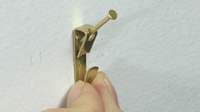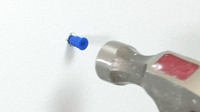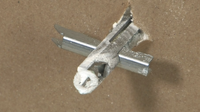You don't the permission to view this video
There is not only an art to hanging pictures and other decorative pieces on walls, there is a science to it. You need the right hardware and hollow wall anchors to make sure your wall hanging stays put too. After watching this video, you’ll have the knowledge you need to hang up your prized pieces with confidence.
You’ve probably heard that the best way to hang a picture so it doesn’t fall off the wall is to hang it from nail or a screw driven into a wall stud. That’s good advice, but unfortunately it’s not always that simple. Aside from the fact that studs can be tricky to locate behind the wall, perhaps you want to hang your masterpiece in between wall studs. Then what do you do? Well, today I’m going to show you.
First, we’ll demonstrate how to locate studs within the wall using some old fashioned, as well as a modern-day methods. Then we’ll teach you how to choose the right hardware for the job if you need to place your wall hanging in between studs. So let’s get started.
Regardless of where you plan to locate a wall hanging, it’s a good idea to understand the basic anatomy of a wall. This is the inside of a typical wall. Most walls are constructed with 2-by-4 or 2-by-6 framing lumber spaced 16-inches apart. These are called wall studs, and drywall or plaster is fastened to these studs using screws or nails.
Drywall is often referred to as wall board, sheet rock or gypsum board. It is typically made of a gypsum core with a paper facing on both sides. It comes in various thicknesses, but in most residential applications is generally ½” thick.
Gypsum is a chalk-like substance that is prone to crumbling. Unlike wood, it can’t support much weight on its own without some additional help. That’s why locating a wall stud is so important. When fastened through the drywall and into a wooden stud, the holding power of a nail or screw increases substantially.
There are several ways to locate a stud in the wall. The old standby method is to knock repetitively across the wall until you hear a difference in sound. You may also notice a difference in the wall’s resistance to your knocking. These are signals that the density in the wall has changed, which indicates where the stud is located. The problem with this method is it’s not always accurate. Without being able to see behind the wall, it’s hard to be precise.
Magnetic stud finders like this one rely on finding studs by locating a fastener in the drywall, such as a nail or a screw. However, they are only as accurate as the placement of the fastener.
That’s where an electronic stud finder comes in handy. Like knocking on the wall, the stud finder is designed to locate a stud by scanning changes in the wall’s density. Unlike your knuckle, however, it’s a lot more accurate. Some stud finders can even detect live electrical wires behind the wall. And that’s a feature worth the extra cost.
This stud finder is designed to locate the center of the stud. Others locate the edge of the stud. To use it, simply press the button and pull the stud finder across the wall. It will indicate when you have found the center of the stud. Studs are only 1-1/2 inches thick, so be sure to predrill your hole straight into the stud and not at an angle. Then, screw the screw into the predrilled hole.
But what if the best place to hang your favorite painting is in between studs? Depending on the weight of your wall hanging, you might need something designed for this specific application.
For lighter wall hangings that weigh 20 pounds or less, you might choose a traditional picture hook, or an expanding plastic sleeve anchor, like these. For heavier wall hangings, you’ll want something with more holding power, like these toggle anchors or molly bolts. Let’s take a closer look at how some of these work.
We’ll start with something you’ve probably used before … the conventional picture hook. To install it simply hammer the nail in at the angle determined by the guide holes. The increased leverage from the hook’s design and the angle of the nail is what gives it its holding power.
Expanding plastic sleeve anchors, on the other hand, help strengthen the screw’s holding power in the drywall itself. The sleeve is first inserted into a pre-drilled hole in the drywall. The size of the hole you drill depends on the size of the sleeve.
When a screw is drilled into the sleeve, the circumference of the sleeve expands and tightens around the hole. Some expanding plastic sleeves, like this one, don’t require pre-drilling. With its auger sleeve design, it screws directly into drywall.
When it comes to hanging heavier objects between studs, you’ll need something with even more holding power.
That’s when you’ll need a hollow wall anchor designed to lever against or clamp down on the back of the drywall, which dramatically increases holding power.
For example, this hook gets its holding power from its unique design. After it’s inserted into the drywall, it levers against the back of the drywall when weight is placed on the hook. They come in different thicknesses, and depending on the thickness of the drywall, these hooks can hold between 50 and 75 pounds.
This anchor is called a molly bolt. It features a threaded sleeve that expands and clamps onto the back of drywall as the bolt is tightened.
Toggle bolts also clamp the back of the drywall. This type of toggle springs open once inside the wall. When the bolt is turned, it then clamps to the back of the wall. The increased holding power of toggle bolts comes from how these anchors can be tightened against the back of the drywall. Some are rated to hold up to 100 pounds. But always be sure to carefully read and follow the manufacturer’s instructions when installing any hollow wall anchor. Also note the maximum rated holding power of the anchor you choose.
That should just about do it. A simple check with a level and you’re all set.
If you have questions about this or any other home improvement project, be sure to read our list of Frequently Asked Questions for this video. And be sure to print out our Project Instructions, which includes a Tools and Materials checklist, before visiting your local independent home improvement retailer. That’s where you’ll find all the products and helpful advice to complete your project. If you’re not sure where to find your local store, check out our Store Locator.
Good luck with your project and thanks for watching.
Steps
- 1.

Try and place a nail where a stud is located behind the wall. The solid wooden beam will better support the nail. Check out the three best ways to detect at stud in steps 2, 3 and 6.
- 2.

Detect a stud: tap along the wall until you hear a difference in sound. This is not always accurate.
- 3.

Detect a stud: Using a magnetic stud finder to locate a metal fastener in the wall.
- 4.

Detect a stud: An electronic stud finder is very accurate and can locate the center of a stud.
- 5.

For wall hangings under 20 pounds, use a traditional picture hook or an expanding plastic sleeve holder.
- 6.

For heavier wall hangings, use toggle hangers or molly bolts.
- 7.

The picture hook can be easily installed by hammering the nail into the designated hole.
- 8.

For sleeve anchors, drill a hole and lightly tap the plastic sleeve into the hole. Simply drill in the screw after. Check out the three best ways to hang a heavy frame below.
- 9.

Heavier frames: A Hercules Hook can easily be pushed into the wall and can hold up to 75 pounds.
- 10.

Heavier frames: A molly bolt has threaded sleeves that expand as the screw tightens.
- 11.

Heavier frames: Toggle hangers have anchors the pop out once behind the wall.




Comments (0)